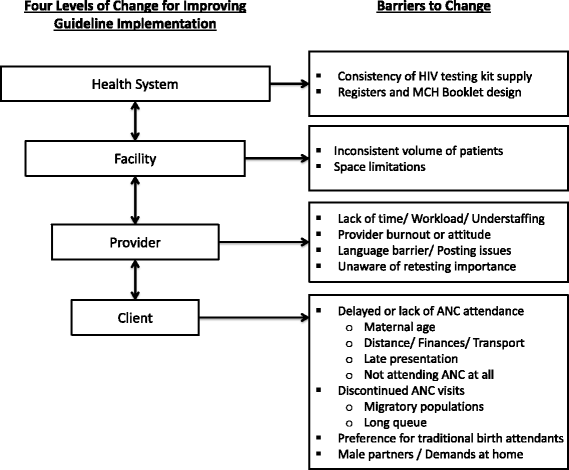Implementation of repeat HIV testing during pregnancy in Kenya: a qualitative study
- PMID: 27401819
- PMCID: PMC4940827
- DOI: 10.1186/s12884-016-0936-6
Implementation of repeat HIV testing during pregnancy in Kenya: a qualitative study
Abstract
Background: Repeat HIV testing in late pregnancy has the potential to decrease rates of mother-to-child transmission of HIV by identifying mothers who seroconvert after having tested negative for HIV in early pregnancy. Despite being national policy in Kenya, the available data suggest that implementation rates are low.
Methods: We conducted 20 in-depth semi-structured interviews with healthcare providers and managers to explore barriers and enablers to implementation of repeat HIV testing guidelines for pregnant women. Participants were from the Nyanza region of Kenya and were purposively selected to provide variation in socio-demographics and job characteristics. Interview transcripts were coded and analyzed in Dedoose software using a thematic analysis approach. Four themes were identified a priori using Ferlie and Shortell's Framework for Change and additional themes were allowed to emerge from the data.
Results: Participants identified barriers and enablers at the client, provider, facility, and health system levels. Key barriers at the client level from the perspective of providers included late initial presentation to antenatal care and low proportions of women completing the recommended four antenatal visits. Barriers to offering repeat HIV testing for providers included heavy workloads, time limitations, and failing to remember to check for retest eligibility. At the facility level, inconsistent volume of clients and lack of space required for confidential HIV retesting were cited as barriers. Finally, at the health system level, there were challenges relating to the HIV test kit supply chain and the design of nationally standardized antenatal patient registers. Enablers to improving the implementation of repeat HIV testing included client dissemination of the benefits of antenatal care through word-of-mouth, provider cooperation and task shifting, and it was suggested that use of an electronic health record system could provide automatic reminders for retest eligibility.
Conclusions: This study highlights some important barriers to improving HIV retesting rates among pregnant women who attend antenatal clinics in the Nyanza region of Kenya at the client, provider, facility, and health system levels. To successfully implement Kenya's national repeat HIV testing guidelines during pregnancy, it is essential that these barriers be addressed and enablers capitalized on through a multi-faceted intervention program.
Keywords: Guideline implementation; HIV counseling and testing; Kenya; PMTCT; Pregnancy.
Figures
Similar articles
-
Barriers and facilitators to HIV and syphilis rapid diagnostic testing in antenatal care settings in low-income and middle-income countries: a systematic review.BMJ Glob Health. 2022 Nov;7(11):e009408. doi: 10.1136/bmjgh-2022-009408. BMJ Glob Health. 2022. PMID: 36319030 Free PMC article.
-
Implementation of repeat HIV testing during pregnancy in southwestern Kenya: progress and missed opportunities.J Int AIDS Soc. 2017 Dec;20(4):e25036. doi: 10.1002/jia2.25036. J Int AIDS Soc. 2017. PMID: 29236362 Free PMC article.
-
Factors affecting acceptance of at-birth point of care HIV testing among providers and parents in Kenya: A qualitative study.PLoS One. 2019 Nov 22;14(11):e0225642. doi: 10.1371/journal.pone.0225642. eCollection 2019. PLoS One. 2019. PMID: 31756242 Free PMC article.
-
Utilization of PMTCT services and associated factors among pregnant women attending antenatal clinics in Addis Ababa, Ethiopia.BMC Pregnancy Childbirth. 2014 Sep 19;14:328. doi: 10.1186/1471-2393-14-328. BMC Pregnancy Childbirth. 2014. PMID: 25234199 Free PMC article.
-
A comprehensive review of the barriers and promoters health workers experience in delivering prevention of vertical transmission of HIV services in sub-Saharan Africa.AIDS Care. 2016;28(6):778-94. doi: 10.1080/09540121.2016.1139041. Epub 2016 Feb 17. AIDS Care. 2016. PMID: 26883903 Free PMC article. Review.
Cited by
-
Active pediatric HIV case finding in Kenya and Uganda: A look at missed opportunities along the prevention of mother-to-child transmission of HIV (PMTCT) cascade.PLoS One. 2020 Jun 2;15(6):e0233590. doi: 10.1371/journal.pone.0233590. eCollection 2020. PLoS One. 2020. PMID: 32484815 Free PMC article.
-
Barriers and facilitators to HIV and syphilis rapid diagnostic testing in antenatal care settings in low-income and middle-income countries: a systematic review.BMJ Glob Health. 2022 Nov;7(11):e009408. doi: 10.1136/bmjgh-2022-009408. BMJ Glob Health. 2022. PMID: 36319030 Free PMC article.
-
HIV retesting for pregnant and breastfeeding women across maternal child health services in Nampula, Mozambique.PLoS One. 2023 Mar 24;18(3):e0283558. doi: 10.1371/journal.pone.0283558. eCollection 2023. PLoS One. 2023. PMID: 36961842 Free PMC article.
-
Pathways for HIV Prevention Behaviors Following a Home-Based Couples Intervention for Pregnant Women and Male Partners in Kenya.AIDS Behav. 2020 Jul;24(7):2091-2100. doi: 10.1007/s10461-019-02774-4. AIDS Behav. 2020. PMID: 31894444 Free PMC article. Clinical Trial.
-
Retest and treat: a review of national HIV retesting guidelines to inform elimination of mother-to-child HIV transmission (EMTCT) efforts.J Int AIDS Soc. 2019 Apr;22(4):e25271. doi: 10.1002/jia2.25271. J Int AIDS Soc. 2019. PMID: 30958644 Free PMC article.
References
-
- World Health Organization . Global Monitoring Framework and Strategy: for the Global Plan towards the elimination of new HIV infections among children by 2015 and keeping their mothers alive (EMTCT) Geneva: World Health Organization; 2012.
-
- Drake A, Wagner A, Richardson B, John-Stewart G. Incident HIV during pregnancy and postpartum and risk of mother-to-child HIV transmission: a systematic review and meta-analysis. PLoS Med. 2014;11(2):1-16. http://dx.doi.org/10.1371/journal.pmed.1001608. - DOI - PMC - PubMed
-
- Johnson LF, Stinson K, Newell ML, Bland RM, Moultrie H, Davies MA, et al. The contribution of maternal HIV seroconversion during late pregnancy and breastfeeding to mother-to-child transmission of HIV. J Acquir Immune Defic Syndr. 2012;59(4):417–25. doi: 10.1097/QAI.0b013e3182432f27. - DOI - PMC - PubMed
-
- Fisher JD, DelGado BP, Melchreit R, Spurlock-McLendon J. The dynamics of repeat HIV testing, and interventions for repeat HIV testers. AIDS Behav. 2002;6(2):183–91. doi: 10.1023/A:1015405416826. - DOI
-
- Republic of Kenya Ministry of Health, National AIDS and STI Control Programme. Guidelines for prevention of mother to child transmission (PMTCT) of HIV/AIDS in Kenya. Nairobi:Ministry of Health, Government ofKenya; 2012.
MeSH terms
Substances
Grants and funding
LinkOut - more resources
Full Text Sources
Other Literature Sources
Medical


